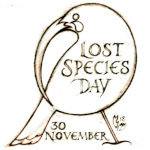Remembrance Day for Lost Species Date in the current year: November 30, 2025
 Remembrance Day for Lost Species, also known as Lost Species Day, is observed annually on November 30. It was created to explore the stories of species that have been driven to extinction and to highlight the importance of conservation efforts.
Remembrance Day for Lost Species, also known as Lost Species Day, is observed annually on November 30. It was created to explore the stories of species that have been driven to extinction and to highlight the importance of conservation efforts.A species is declared extinct when its last member dies. Species can also be declared functionally extinct when their population is no longer viable (for example, there are no individuals capable of reproducing) or extinct in the wild when the only living members of a species are kept in captivity. Species that are extinct in the wild can be reintroduced and saved from total extinction, but this is a long and arduous process with no guarantee of success.
It is estimated that more than 99% of the species that have lived on Earth throughout the history of the planet have become extinct. Although extinction is considered a natural part of the evolutionary process, the current rate of extinction is too high to be natural. Population growth and human activities are thought to be the main causes of biodiversity loss over the past two centuries.
Species are driven to extinction or the brink of extinction by habitat loss and fragmentation caused by human activities, climate change, overhunting and overfishing, poaching, illegal wildlife trade, diseases spread by human travel and the wildlife trade, and other human-related factors. Studies suggest that between 50% and 70% of all existing plant and animal species will be extinct within a century or so if the exploitation and destruction of the biosphere continues at the current rate.
Remembrance Day for Lost Species was co-founded in 2011 by the founders of Feral Theatre and the Life Cairn memorial program. It is a volunteer-led campaign with no legal structure, managed administered mainly by the Brighton-based arts charity ONCA and the co-directors of Feral Theatre. Lost Species Day provides an opportunity to explore the stories of species, habitats, ways of life, and cultures that have been driven to extinction by exploitation and unjust power structures. It emphasizes that the roots of these extinctions lie in discriminatory, exploitative, and violent political and economic practices.
There are many ways to participate in Remembrance Day for Lost Species. You can create an art project to raise awareness of extinct and endangered species, light a candle of remembrance, organize a memorial procession or demonstration, donate or volunteer for a conservation organization of your choice, visit a zoo that participates in conservation programs, symbolically adopt an endangered animal, organize a cleanup, plant a tree, etc.
From 2011 to 2021, the organizers suggested a key extinct species or theme for Lost Species Day events to focus on, although following the theme was optional. Past themes included the great auk, extinct butterfly species, the Caribbean monk seal, threatened and extinct amphibians, the passenger pigeon, the thylacine (Tasmanian wolf), lost and disappearing pollinators, Steller’s sea cow, the intersectional environmental movement, interdependence, and more. However, there has been no theme of the day since 2022, and participants are welcome to focus on whatever stories they want to explore.
- Category
- International Observances, Ecological Observances
- Tags
- Remembrance Day for Lost Species, Lost Species Day, international observances, environmental observances, extinct species